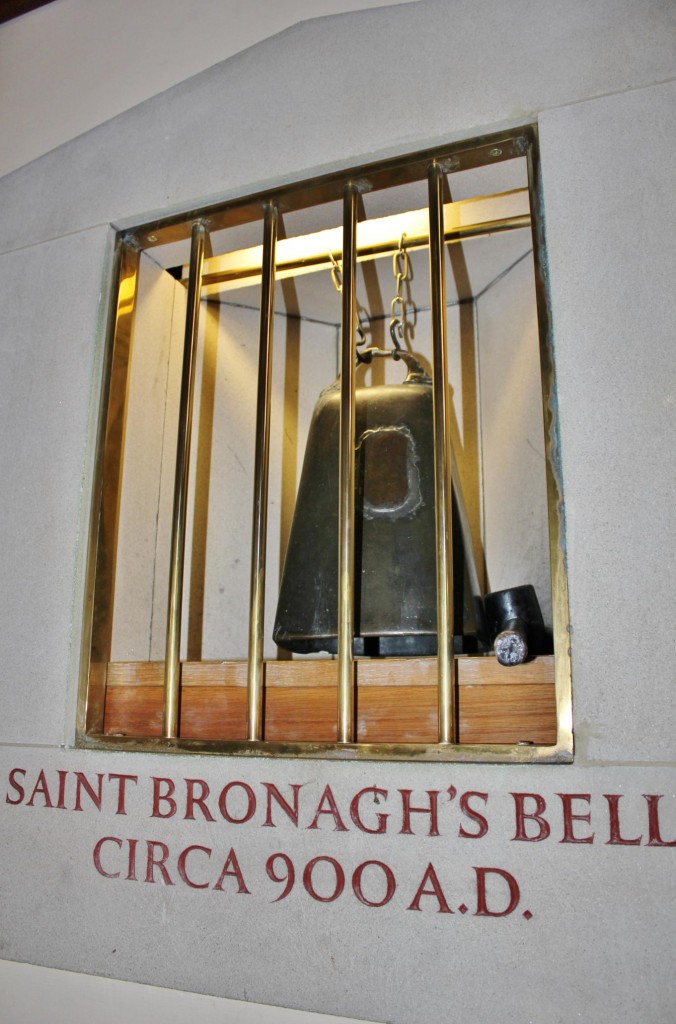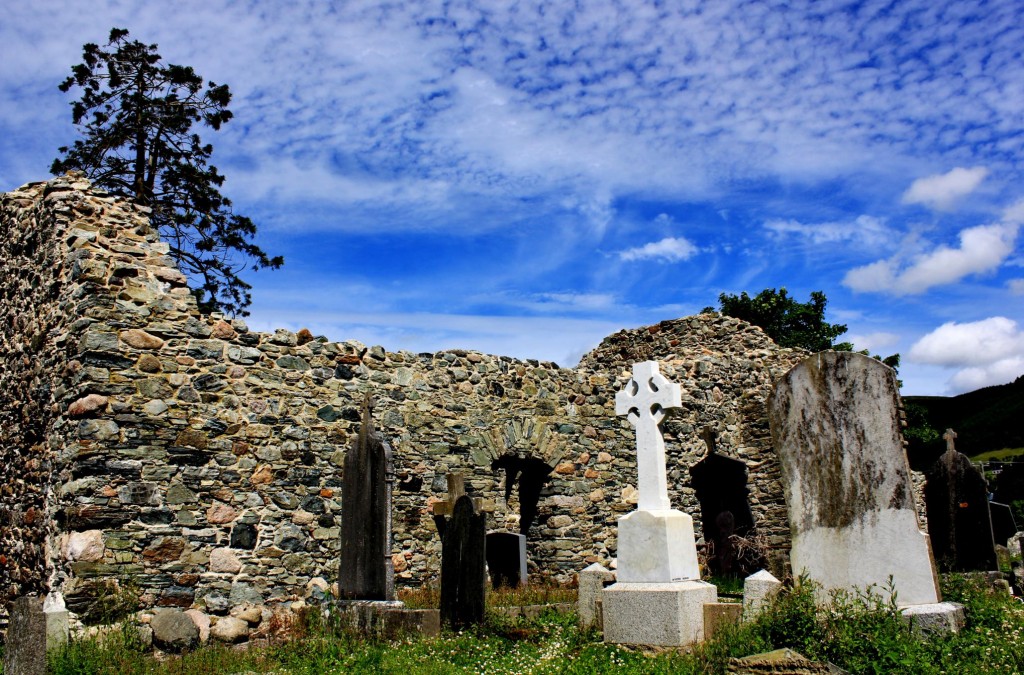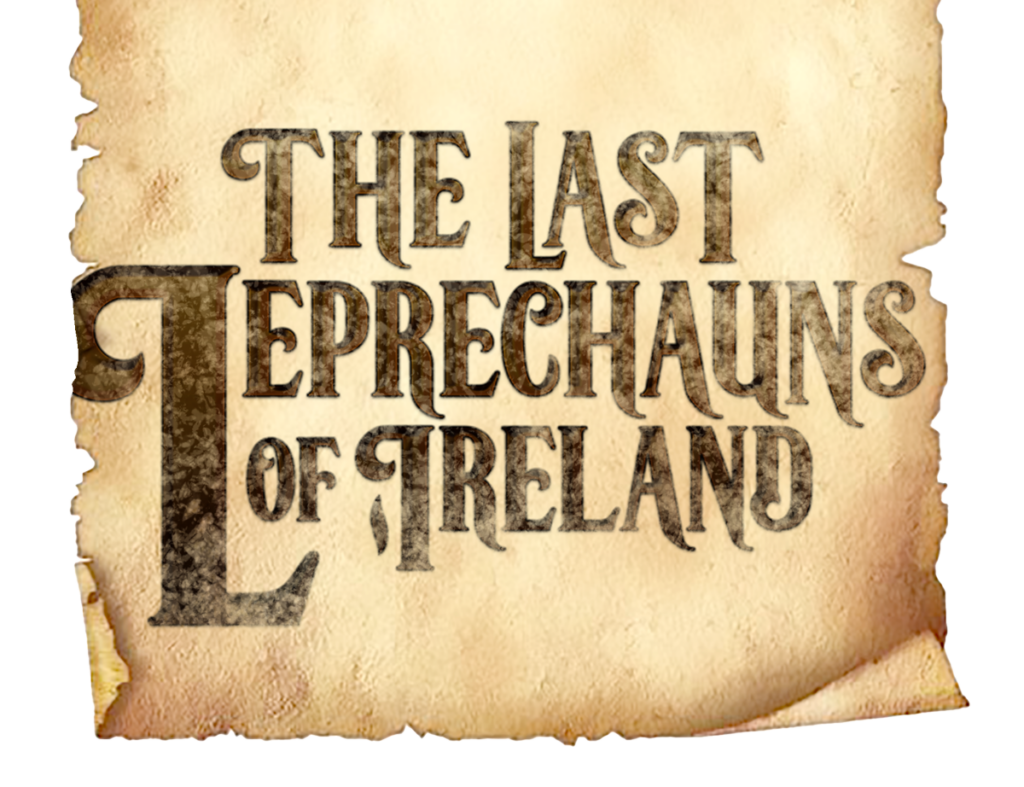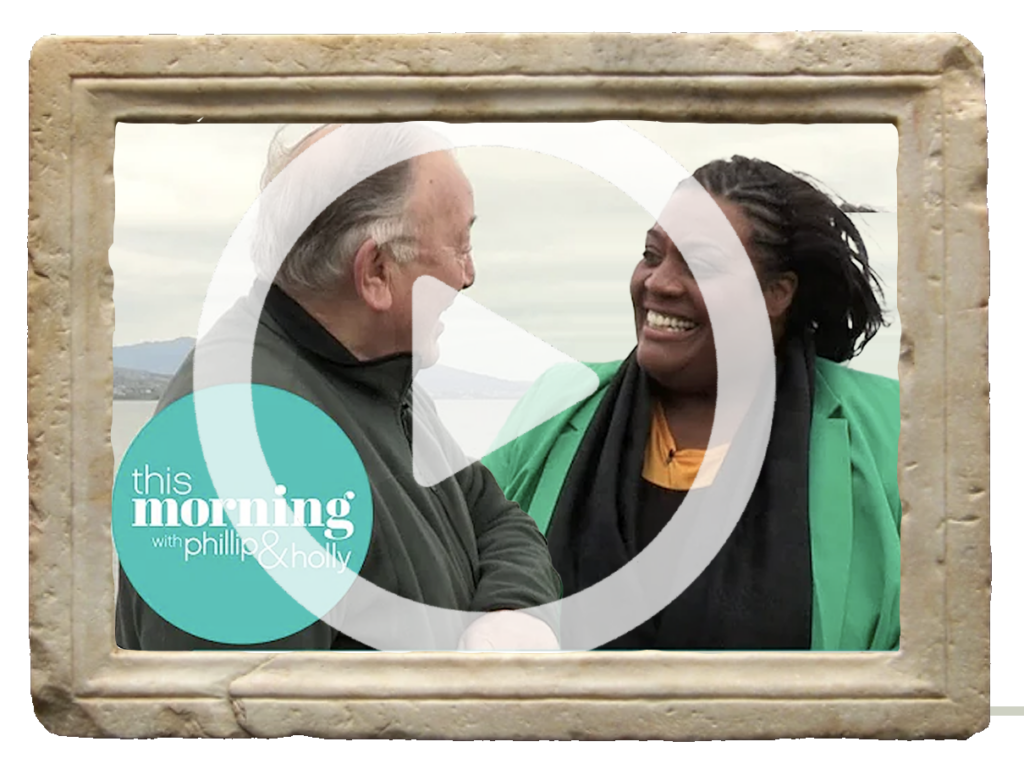The Hidden Bell of Bronach
Kilbroney , Rostrevor Co. Down
A young chieftain of Glen Secis ,called Fergus hunted wild deer in the Mourne Mountains with warriors and wolf-hounds. They had just killed a hind at a place called Deer’s Meadow when a violent storm forced them to shelter in a cave. As they waited for it to pass, a mighty stag passed the cave entrance and made its way up the mountain in spite of the atrocious weather. They lost sight of it as it disappeared into the rain clouds.
He was such a noble looking animal that Fergus resolved to capture it and headed up the mountain after it with his favourite hound. He himself soon disappeared out of sight of the others and into the mists. His hound was on the scent and was soon rushing forward to attack it. To Fergus’ surprise he saw another, Chief Artan of Lecale and his hound pursuing the same stag. Fergus was enraged, for his clan and that of the clan of Artan were bitter enemies. Both hounds attacked the stag, but the stag caught the hound of Artan with his mighty antlers and gored it to death. Artan was so enraged that he threw a spear to kill the stag but instead killed the hound of Fergus.

Fergus was so overcome with anger at the death of his favourite hound that he took an arrow from his quiver and fired it at Artan killing him instantly. The body rolled down the mountain and came to a halt at a small oak tree. Without looking back at the dead man, the distraught Fergus full of grief for the dead hound, slung it over his shoulders and headed down the mountain. As time passed and his anger subsided he felt remorse for the deed he had done. The longer time went on the worse he felt, till finally racked with guilt he gathered craftsmen together who could make a bell of hammered metal and twelve bronze candlesticks. To atone for his misdeed he presented it to Saint Broach and her religious community in Glen Secis.
St Bronagh placed the bell between the forked branches of a young oak tree that grew near the church.The bell tolled each day for the dead Artan and became a source of calm for Fergus when he would hear its soft tone echo through the Mourne valleys. A local hermit suggested to Fergus that to atone for his wrongdoing that he should also give up leadership of his clan, don sackcloth and ashes and leave the area entirely. He took off as a pilgrim and travelled the roads seeking shelter where he could and doing good to all does he met.
As he grew old he longed to go back to his native place once more, his penance done. On arrival back, the sight that greeted him was unimaginable. The glen had been ravaged by the Danes, the convent was in ruins, the religious were gone, and among the ruins beside an ancient cross knelt a very old man.
What happened here? asked Fergus.
The old man related what had happened over the previous 50 years; it transpired that the old man was Artan whom Fergus thought that he had killed so many years before. But no; he hadn’t died; he had been rescued by shepherds and nursed back to health. He had heard how Fergus had had the bell made in his memory and how he had atoned for what he thought was the death of Artan.

Both men embraced: the bitterness was gone, tears welled up in their eyes and a soft wind blew through the trees causing the bell to ring. It was a joyous sound to everyone who heard it. In that moment Fergus collapsed, clutching the hand of Artan and begging his forgiveness. He closed his eyes and fell still.
For 1000 years the bell was heard to chime in Kilbroney cemetery. Nobody could pinpoint where it came from, its echo sounding in different places misleading those who sought to find it. For generation after generation the sound was no more and the story became nearly folklore, though some said they could often hear it when a soft breeze shook the trees.
In the year 1885 a large oak tree standing near Kilbroney church was blown down in a terrible storm. Men were sent to cut it. They stripped it and began to saw off the two great branches that forked at the top. To their astonishment they discovered the bell in the recess it had been placed many years before. The ring which held its tongue had worn away with constant use, and the tongue had fallen to the bottom of the recess. It was sent to Dublin for examination and it was agreed by all who saw it that it was akin to the earliest Christian consecrated bells discovered in this country.
Bronach’s bell still rings, it was placed in the Catholic Church in Rostrevor in Co. Down and is there to this day
A young chieftain of Glen Secis called Fergus hunted wild deer in the Mourne Mountains with warriors and wolf-hounds. They had just killed a hind at a place called Deer’s Meadow, when a violent storm forced them to shelter in a cave. As they waited for it to pass, a mighty stag passed the cave entrance and made its way up the mountain in spite of the atrocious weather. They lost sight of it as it disappeared into the rain clouds.
He was such a noble looking animal that Fergus resolved to capture it and headed up the mountain after it with his favourite hound. He himself soon disappeared out of sight of the others and into the mists. His hound was on the scent and was soon rushing forward to attack it. To Fergus’ surprise he saw another; Chief Artan of Lecale and his hound pursuing the same stag. Fergus was enraged, for his clan and that of the clan of Artan were bitter enemies. Both hounds attacked the stag but the stag caught the hound of Artan with his mighty antlers and gored it to death. Artan was so enraged that he threw a spear to kill the stag but instead killed the hound of Fergus.
Fergus was so overcome with anger at the death of his favourite hound that he took an arrow from his quiver and fired it at Artan killing him instantly. The body rolled down the mountain and came to a halt at a small oak tree. Without looking back at the dead man, the distraught Fergus full of grief for the dead hound, slung it over his shoulders and headed down the mountain. As time passed and his anger subsided he felt remorse for the deed he had done. The longer time went on the worse he felt, till finally racked with guilt he gathered craftsmen together who could make a bell of hammered metal and twelve bronze candlesticks. To atone for his misdeed he presented it to Saint Bronach and her religious community in Glen Secis.
St Bronagh placed the bell between the forked branches of a young oak tree that grew near the church. The bell tolled each day for the dead Artan and became a source of calm for Fergus when he would hear its soft tone echo through the Mourne valleys. A local hermit suggested to Fergus that to atone that he should also give up leadership of his clan, don sackcloth and ashes and leave the area entirely. He took off as a pilgrim and travelled the roads seeking shelter where he could and doing good to all does he met.
As he grew old he longed to go back to his native place once more his penance done. On arrival back, the sight that greeted him was unimaginable. The glen had been ravaged by the Danes, the convent was in ruins, the religious were gone, and among the ruins beside an ancient cross knelt a very old man.
What happened here? asked Fergus.
The old man related what had happened over the previous 50 years, it transpired that the old man was Artan whom Fergus thought that he had killed so many years before. But no he hadn’t died he had been rescued by shepherds and nursed back to health. He had heard how Fergus had had the bell made in his memory and how he had atoned for what he thought was the death of Artan.
Both men embraced and the bitterness was gone, tears welled up in their eyes and a soft wind blew through the trees causing the bell to ring. It was a joyous sound to everyone who heard it. In that moment Fergus collapsed, clutching the hand of Artan and begging his forgiveness. He closed his eyes and fell still.
For 1000 years the bell was heard to chime in Kilbroney cemetery. Nobody could pinpoint where it came from, its echo sounding in different places misleading those who sought to find it. For generation after generation the sound was no more and the story became nearly folklore, though some said they could often hear it when a soft breeze shook the trees.
In the year 1885 a large oak tree standing near Kilbroney church was blown down in a terrible storm. Men were sent to cut it. They stripped it and began to saw off the two great branches that forked at the top. To their astonishment they discovered the bell in the recess it had been placed many years before. The ring which held its tongue had worn away with constant use, and the tongue had fallen to the bottom of the recess. It was sent to Dublin for examination and it was agreed by all who saw it that it was akin to the earliest Christian consecrated bells discovered in this country.
Bronach’s bell still rings, it was placed in the Catholic Church in Rostrevor in Co. Down and is there to this day






